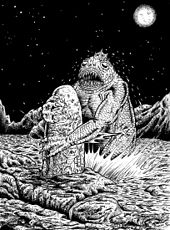Dagon (short story)
Dagon is a 1917 short story by HP Lovecraft, making it one of his earliest adult works. The story was first published in the November 1919 issue of The Vagrant , an amateur press magazine of the time, edited by W. Paul Cook . Lovecraft, in his own words, was inspired to write this story through a dream.
action
The short story is laid out as the will of a man addicted to morphine who, before he committed suicide, tells of a horrific experience in which he lost his sanity and became addicted to drugs.
In the early days of the First World War , the narrator was sailing the Pacific as an officer on a merchant ship when a German warship captures his freighter and takes the crew prisoner. Equipped with enough provisions, he manages to escape from captivity on a lifeboat. After drifting aimlessly on the sea for some time, one morning after restless dreams he finds himself stranded in a seemingly endless, black and slimy marshland, which is covered by rotting fish and other, partly unknown marine animals. He suspects that an "unprecedented volcanic elevation" must have pushed the sea floor to the surface.
After the soil has dried sufficiently in the sun, he embarks on a day-long hike to a distant “hill” in the west. However, this turns out to be much higher and is located behind a deep gorge, the bottom of which is covered with water. At the edge of this water channel he finds a huge white stone, which he describes as a well-formed monolith , covered with unknown hieroglyphics of aquatic animals such as "fish, eels, octopuses, crustaceans, mollusks, whales, etc." There are also images of human-like beings among them, but they have enormous proportions and body features of fish.
While he is looking at the monolith, a creature, "huge as Polyphemus ", suddenly rises from the water, embraces the monolith and makes terrible noises. Mad with fear, the sailor flees up the slope and back to his boat. His last fuzzy memory is that of a great storm.
When he comes to, he finds himself in a hospital in San Francisco , where he was taken by an American ship after being rescued. Nothing is known about land emerged from the sea; the rescued prefers to remain silent about his experience. Once he asked - but without result - a famous ethnologist about the fish god Dagon of the Philistines .
Using drugs like morphine , he tries to forget the terrible experience and the recurring dreams and visions of the monster. He fears that the “nameless things” living in the depths of the ocean, the images of which he saw on the monolith, will one day come to the surface and “the meager remnants of a war-weakened humanity” will fall into ruin. The story ends with the words:
"The end is near. I hear a noise at the door, as of some immense slippery body lumbering against it. It shall not find me. God that hand! The window! The window! "
"The end is near. I hear a noise at the door, as if an enormous slippery body was pressing against it. He shouldn't find me. God, that hand! The window! The window!"
Adaptations
In 2001 the film Dagon was released; Despite having the same name, the film is largely based on Lovecraft's novella Shadows over Innsmouth , which was made a decade later as Dagon .
In 2020, Dagon was edited as a radio play for the first time by Markus Winter as part of the radio play series Howard Phillips Lovecraft - Chronicles of Horror .
Web links
Individual evidence
- ↑ InvisibleFriend u. a .: The Vagrant. In: ZineWiki - the independent media wikipedia. Retrieved November 10, 2012 .
- ^ HP Lovecraft, "In Defense of Dagon," Miscellaneous Writings , p. 150; cited in ST Joshi and David E. Schultz, "Dagon," An HP Lovecraft Encyclopedia , p. 58.

